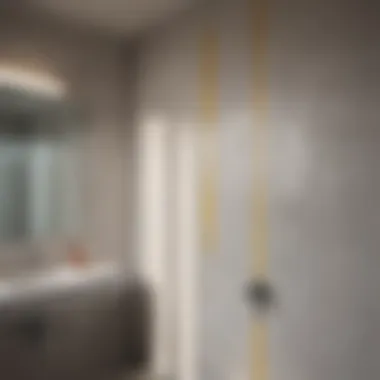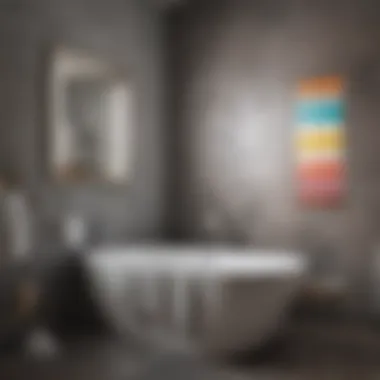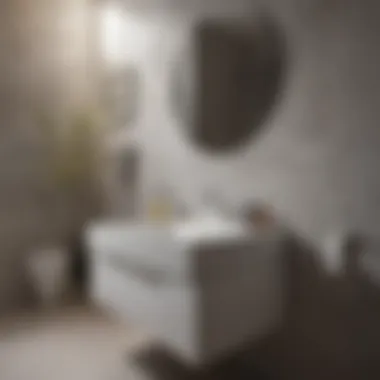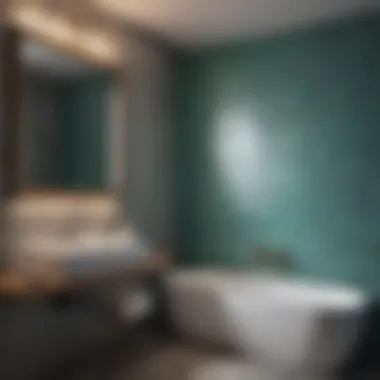How to Calculate Paint Needs for Small Bathrooms


Intro
In the realm of home improvement, the significance of selecting the right amount of paint for a small bathroom cannot be overstated. Homeowners and renters alike face the challenge of transforming compact spaces effectively. An accurate calculation of paint requirements can save both time and money. Understanding various factors that influence paint consumption is essential to achieving a successful outcome. This guide aims to provide clarity on the necessary steps for measuring and estimating paint needs for small bathrooms.
Design Inspirations
The design of a bathroom may significantly impact the choice of paint. Creating an inviting and stylish atmosphere often starts with the right color and finishes. When planning for painting, it can be helpful to consider both trends and palettes that resonate with personal taste.
Trending Styles
Some popular styles in bathroom design include:
- Modern Minimalism: Focuses on clean lines and functionality, often incorporating neutral colors.
- Vintage Charm: Embraces classic colors, floral patterns, and decorative elements.
- Coastal Vibes: Utilizes soft blues and whites, evoking a serene seaside feeling.
These styles can influence the selection of paint, thereby affecting the amount needed. Opting for a style can narrow down color choices, making the decision-making process more efficient.
Color Palettes
Choosing the right color palette is a crucial step. Here are some options:
- Monochromatic: Selecting various shades of a single color can create depth and sophistication.
- Contrasting Colors: Using complementary colors can add vibrancy to the space.
- Pastels: Soft hues can promote a calming ambiance in small areas.
When determining paint requirements, it's wise to keep in mind that darker colors may require more coats than lighter shades. Thus, understanding color choices can greatly influence how much paint you will need ultimately.
Key Considerations for Paint Calculation
Several factors need attention while calculating paint needs.
Measuring Wall Area
Accurate measurements are vital. Measure each wall individually and note the total area. Subtract areas for doors and windows, as these will not require painting.
Paint Coverage
Different paint types have various coverages per gallon. Usually, a gallon covers approximately 350-400 square feet, but always check the can for specifics. Consider that textured surfaces may require more paint.
Unique Bathroom Factors
Bathrooms often contain moisture, leading to the need for specialized paints. This is especially true for mold and mildew resistance. Such paints might also have different coverage characteristics, which can impact the total amount needed.
The End
"Taking the time to accurately estimate your paint needs will result in less waste and a more enjoyable project."
Through this detailed examination, homeowners and renters can approach their painting projects equipped with the knowledge to achieve effective results.
Prologue to Painting a Small Bathroom
Painting a small bathroom may seem straightforward, yet it encompasses various critical elements that require detailed consideration. Understanding how to effectively calculate paint requirements is essential for achieving a satisfying outcome. Since bathrooms typically feature unique dimensions, fixtures, and moisture, these factors influence how much paint is necessary. An accurate assessment allows homeowners and renters alike to plan their projects efficiently, minimizing waste and ensuring a flawless finish.
Importance of Proper Planning
Proper planning is the backbone of any successful painting endeavor. It begins with a thorough understanding of what the space entails. Bathrooms often include niches for cabinets, shelves, and plumbing fixtures. Each of these elements can significantly influence the amount of paint required. By having a clear plan, one can avoid unforeseen surprises that can lead to overspending or inadequate coverage.
Moreover, well-thought-out planning helps ensure that the chosen color scheme harmonizes with the existing decor. Paint interacts differently with various lighting conditions, which can alter the final appearance. Thus, investing time in planning is not just about paint calculations but also about achieving a cohesive aesthetic.
Common Challenges in Small Bathrooms


Small bathrooms present unique challenges that make calculating paint requirements more complex. One primary issue is the limited wall space. Unlike larger areas, every square foot counts. Fixtures such as vanities, sinks, and bathtubs must also be taken into account when calculating total wall area. Neglecting these can lead to an inaccurate estimate of required paint.
Another challenge arises from the high humidity levels typically present in bathrooms. This environment often demands specialized paint types to ensure durability and longevity. Additionally, moisture can affect drying times and paint adherence, further complicating the painting process.
Accurate calculation of paint requirements is essential to avoid both waste and dissatisfaction.
Overall, approaching the project with an understanding of these challenges will set the stage for a successful painting experience. Careful planning and awareness of common pitfalls significantly enhance the probability of an effective transformation.
Understanding Bathroom Dimensions
Understanding bathroom dimensions is crucial when assessing paint requirements for your small bathroom. This knowledge not only informs how much paint is necessary but also helps to ensure a well-executed painting project. Accurately measuring your bathroom can lead to more precise estimates, preventing overspending or running short on paint mid-project. Additionally, it can influence the overall aesthetics and functionality of the space.
Measuring Wall Area
The first step in calculating paint requirements involves measuring the wall area. Start by using a tape measure to obtain the height and width of each wall. Multiply the height by the width to get the area of each wall. This process should be repeated for all walls in the bathroom.
It is beneficial to note the total height of the walls, as bathrooms often have variations due to ceiling fixtures or variations in wall texture. For example, if your bathroom has 8-foot tall walls and a width of 10 feet, the area calculation would appear like this:
- Wall Area = Height × Width
- Wall Area = 8 ft × 10 ft = 80 sq ft
Add up the areas for all walls to get the total wall area you need to paint, taking special care to account for any intricacies in design or shape.
Accounting for Fixtures
After measuring wall dimensions, the next step is to account for fixtures. Fixtures like sinks, toilets, and cabinets occupy wall space and will not require paint. It is essential to measure these installations and subtract their areas from the total wall area calculated previously.
For instance, if you have a sink that measures 3 feet by 2 feet, you would calculate its area:
- Fixture Area = Height × Width
- Fixture Area = 3 ft × 2 ft = 6 sq ft
Once you have the areas of all fixtures, subtract these from the total wall area to find the actual area you will paint.
Calculating Square Footage
Finally, calculating the square footage of the area that requires paint involves taking the remaining wall area after subtracting the fixtures.
For example, if your total wall area is 400 sq ft and you subtract 30 sq ft for fixtures, the calculation looks like this:
- Square Footage to Paint = Total Wall Area - Fixture Area
- Square Footage to Paint = 400 sq ft - 30 sq ft = 370 sq ft
This final number represents the total square footage for which you will need paint.
"Being thorough in measuring and calculating means fewer surprises and smoother execution during your painting project."
Paint Coverage Considerations
When preparing to paint a small bathroom, understanding paint coverage is a critical step. Appropriate coverage leads to efficient resource use and prevents unnecessary costs. Factors like paint type, wall condition, and finishing choices directly influence how much paint is needed. By recognizing these elements, homeowners can budget effectively and ensure a high-quality finish.
Understanding Paint Labels
Paint labels provide essential information that can help you determine how much paint to buy. They typically display the coverage area, measured in square feet, which can often vary by brand. This number will tell you how many square feet a gallon can cover under ideal conditions. Additionally, the label may quote drying times and recommended application methods. Recognizing these aspects is crucial because they affect how the paint performs and how many coats may be necessary to achieve an even finish.
Factors Influencing Coverage
Surface Texture
The surface texture of your bathroom walls is a significant factor in paint coverage. Common textures include flat, semi-gloss, and matte finishes. The smoothness of the surface influences how well paint adheres and spreads. A smooth surface often requires less paint for full coverage. Conversely, textured walls might absorb more paint and require an additional coat, increasing your total paint needs. Choosing the right texture can elevate your bathroom's aesthetic but must be balanced with practical considerations about coverage.
Color Changes


Color changes can also impact paint usage significantly. If you are covering a darker color with a lighter one—or vice versa—you will likely need more coats to achieve your desired look. Paints with high opacity can help minimize this challenge, reducing the total paint needed. It's essential to consider the initial color of the walls and the new color's requirements. A well-chosen color can enhance space; therefore, understanding how color changes affect coverage is a key point.
Type of Paint Finish
The type of paint finish is equally important in determining coverage. Finishes like eggshell, satin, and matte have different levels of reflectivity and durability. For instance, a satin finish often provides better washability and is more durable in moisture-rich environments like bathrooms. However, it might require more paint for coverage compared to a matte option, especially on textured surfaces. Selecting the right finish is not just about aesthetics; it directly impacts how well the paint will perform in your bathroom.
In considering paint for a small bathroom, remember that both surface texture and paint finish can significantly influence your overall paint expenditure.
Estimating Total Paint Needed
Estimating the amount of paint needed for a small bathroom is a crucial step in the painting process. This helps in budgeting and ensures the project runs smoothly. Underestimating can lead to multiple trips to the store and possible mismatches in paint, while overestimating can inflate costs without necessary benefits. By following a systematic approach to estimating paint needs, homeowners can achieve a precise allocation for their painting project. This section discusses essential formulas and considerations that will aid in calculating total paint requirements efficiently.
General Estimation Formula
To begin, one should utilize a basic formula for estimating paint needs. A common approach is to calculate the total wall area and then consider the coverage provided by the paint chosen. The general estimation formula can be expressed as follows:
- Measure wall area: Multiply the width by the height of each wall.
- Account for windows and doors: Subtract the area of any openings from the total wall area.
- Calculate square footage: Add the areas of the remaining walls together.
- Review paint can coverage: Check the label for coverage details, often shown in square feet per gallon.
- Total gallons needed: Divide total wall area by paint coverage.
This calculation helps in understanding how much paint will actually be used on the walls versus how much is wasted. It is always wise to err on the side of caution while estimating.
Adding Extra for Touch-Ups
In painting projects, issues may arise that lead to the need for touch-ups. It's beneficial to add extra paint to your total estimate specifically for these instances.
Percentage of Extra Paint
When calculating for touch-ups, a standard practice is to add about 10 to 15% to your total paint estimation. This percentage allows for the inevitable mistakes or areas that require additional coats. The key characteristic of this approach is its practicality, as it accommodates mishaps that could occur during the application.
Adding this extra amount can also save time and reduce stress. Having that extra paint on hand ensures that any touch-ups match perfectly, as the same batch can be used. It is a beneficial choice as it enhances the overall finish of the project, preventing visible differences in paint color or texture. However, if it is not used, it should be stored properly for future projects to avoid waste.
Reasons for Touch-Ups
There are various reasons why touch-ups might be needed after initial painting.
- Mistakes during application: Accidental spills or drips happen more often than one might imagine.
- Fading or wear over time: Areas that are touched frequently may fade faster, requiring re-application of paint.
- Surface imperfections: Minor damages like scratches or dents can detract from the look of a newly painted wall.
Each of these reasons underscores the importance of considering touch-up paint. The beauty of this step lies in its ability to ensure long-term maintenance of the bathroom's appearance. Having a little extra paint can lead to a more satisfying final result. They allow for future repairs while also maintaining the aesthetic integrity of the painted surfaces.
Choosing the Right Paint Type
Choosing the right paint type is critical when painting a small bathroom. The bathroom's unique environment presents distinct challenges that can affect both the visual appeal and the longevity of the paint job. Moisture levels, durability, and safety concerns all play a significant role in determining the best paint for your needs.
Water-Resistant Options
Water-resistant paint is an essential choice for bathrooms as it helps prevent mold and mildew growth. Bathrooms are often subject to high humidity from showers and baths. Therefore, using paint specifically designed for these conditions is crucial. Look for labels that indicate water resistance or moisture barrier properties, as these features ensure the paint does not deteriorate quickly.
Additionally, consider paints with a satin or semi-gloss finish. These finishes not only resist moisture better than flat paints but also make cleaning easier. It's important to understand the brand's specific offerings; some brands, like Behr and Sherwin-Williams, provide excellent water-resistant formulations that have proven effective.
Eco-Friendly Paints
Eco-friendly paints are a growing consideration for homeowners. These paints contain fewer volatile organic compounds (VOCs), which are harmful emissions that can affect air quality. Opting for low or zero-VOC paints provides a healthier environment, especially in an enclosed space like a bathroom. Brands like Benjamin Moore have developed sustainable options that deliver performance without compromising health.
Moreover, eco-friendly paints often feature biodegradable ingredients, minimizing their environmental impact. When choosing these paints, verify that certifications, such as Green Seal or EcoLogo, support their environmental claims. Being environmentally conscious does not mean sacrificing quality; many eco-friendly paints provide good durability and coverage.
Durability and Finish Type
Durability is another key factor to consider when selecting paint for a small bathroom. A bathroom needs a paint that withstands daily wear and tear while also handling moisture exposure. For this, a hard-wearing finish is vital.


Typically, satin or semi-gloss finishes are recommended for bathroom paint. These finishes are more durable and easier to clean than matte paint. For example, if you choose a satin finish, it provides a balance between gloss and ease of maintenance while still being aesthetically pleasing. Additionally, some brands offer specialized bathroom finishes with added durability, which is worth investigating.
In summary, selecting the right paint type for a small bathroom involves critical considerations such as moisture resistance, eco-friendliness, and finish durability. By carefully evaluating these elements, you can ensure that the paint enhances the bathroom while resisting the challenges posed by its environment.
The Painting Process
Understanding the painting process is crucial for achieving a professional-looking finish in a small bathroom. A systematic approach not only enhances the quality of the work but also ensures efficient use of resources. Proper implementation of this process reduces the likelihood of mistakes, which can be particularly costly and time-consuming.
Prepping the Bathroom
Before applying paint, preparation is essential. It involves more than just covering surfaces with a fresh coat of paint. Begin with gathering necessary materials: painter's tape, drop cloths, sandpaper, sponges, and caulk. Clear the area by removing bathroom items such as towels, toiletries, and decor. This action creates a clean workspace and reduces the risk of paint splatters damaging your belongings.
Wash the surfaces you intend to paint with a mild detergent to remove dirt and grease. Rinse thoroughly with water and allow to dry completely. Sand any rough areas to create a smooth surface for painting. Use painter's tape to protect edges of cabinets, mirrors, and trim. This step is vital in preventing unwanted paint marks on areas that should not be painted.
Additionally, inspect the walls for any cracks or holes. Filling these gaps with caulk or spackling compound ensures an even finish. Allow any repaired sections to dry as per product instructions before proceeding.
Application Techniques
Once the bathroom is prepped, the next step is applying paint. Choosing the right application technique can significantly affect the final appearance of the paint job. One common method is using a roller for larger areas, which provides a smooth finish and covers more surface area. A brush is more suitable for tight spots and corners where the roller cannot reach.
When rolling, apply paint in a W pattern. This technique helps to spread the paint evenly, preventing roller marks. For edges, a brush can help to touch up areas that the roller missed, ensuring no section remains unpainted.
It's essential to allow each coat to dry fully before applying a second coat. The drying time can vary based on factors like humidity and paint type, so follow the manufacturer's instructions. After the final coat, remove painter's tape carefully while the paint is still slightly tacky. This step reduces the chance of peeling paint off the wall.
Always remember: "A well-prepped surface leads to a paint job that lasts longer and stands out more."
In summary, mastering the painting process—from preparation to application—is pivotal in transforming a small bathroom. It requires attention to detail and adherence to best practices for an ideal outcome.
Post-Painting Considerations
Understanding the post-painting considerations is vital after completing a painting project in a small bathroom. This stage addresses the immediate and long-term outcomes of your efforts, ensuring not only the aesthetic appeal but also the durability and functionality of the new paint job. Proper attention to these elements can extend the life of your paint application and maintain the beauty of your bathroom for years to come.
Ventilation and Drying Time
Ventilation is a critical component in the painting process that should not be overlooked. After painting, ensuring proper airflow in the bathroom helps with the drying process, which can vary depending on several factors. Adequate ventilation prevents the buildup of moisture and improves air quality. For instance, the humidity level in many bathrooms tends to be higher, which can slow down drying and promote mold growth.
The general guideline is to keep windows open and exhaust fans running for several hours post-application. This enhances the drying speed of the paint and minimizes the risk of vapors lingering in the enclosed space. Although most paints dry to the touch in a couple of hours, waiting at least 24 hours before using the bathroom can provide a more secure finish.
- Tips for Effective Ventilation:
- Open windows if possible.
- Operate exhaust fans continuously during and after painting.
- Use fans to circulate air.
- Avoid closing doors immediately after painting.
Maintenance Tips
Once the paint is dry, ongoing maintenance becomes crucial for preserving the appearance and integrity of the walls. A well-maintained paint job can dramatically enhance the overall look of a small bathroom. Maintenance demands a few simple practices that can prevent issues before they arise.
- Regular Cleaning: Use a mild detergent mixed with water to wipe down walls occasionally. This prevents dirt buildup and keeps colors vibrant.
- Addressing Damage Quickly: If you notice peeling or chipping, it's best to touch it up immediately. Ensure you have leftover paint for these situations.
- Humidity Control: Given the potential moisture in bathrooms, consider using a dehumidifier or making sure the existing ventilation is functional. This can keep degrading factors at bay.
Closure
Moreover, several key elements come into play when finalizing your painting project. First, understanding measurements specific to your bathroom is essential. This includes the accurate calculation of wall area while accounting for fixtures. Second, knowing the coverage of paint can drastically affect how much you need to purchase. Each paint brand has different coverage rates, influenced by various factors such as surface texture and the type of finish.
Additionally, maintaining good ventilation during and after the painting process is crucial for achieving the best results. Proper maintenance following the painting will help sustain the new look over time.
The benefits of these considerations are manifold. From cost-efficiency to achieving a desired look, each aspect adds value to the overall painting endeavor. As one prepares for a painting project in a small bathroom, these insights serve as a strong foundation for success. Painting should not feel like a daunting task but rather an opportunity to create a revitalized space.
Summarizing Key Points
- Accurate measurements are fundamental before purchasing paint.
- Paint coverage varies by brand and finish; always check labels.
- Ensure the bathroom is well-ventilated during drying periods.
- Maintenance post-painting is crucial for lasting beauty.
- Financial planning is enhanced with clear paint requirements.
Final Thoughts on Painting a Small Bathroom
Painting a small bathroom can be a rewarding project when approached with careful planning and execution. Homeowners should embrace the opportunity to transform an often-overlooked area into something personal and inviting. Understanding unique challenges, like dealing with moisture and tight spaces, can lead to better choices in both paint selection and application.
Ultimately, the goal is to not just paint walls but to create an environment that is both relaxing and functional. Each layer of paint adds not only color but also protection against wear and tear. With adequate preparation and an informed mindset, achieving your ideal bathroom is within reach.



